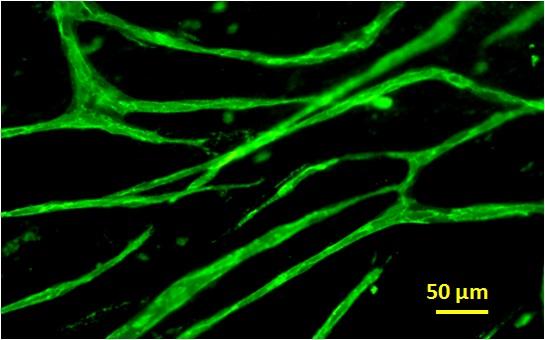
The fluorescent green tubes are the beginnings of veins, capillaries and lymphatic drainages — engineering pre-vascularized tissue like this could help heal severe burn injuries. (Credit: Michigan Tech, Feng Zhao).
Full thickness skin grafts are the golden standard for treating burn wounds. But most skin grafts for severe burns require a donor, and for large or complicated injury sites, a full thickness skin graft is hard to come by. Split thickness skin grafts (STSG) that use tissue from the patient may be a solution–but not by themselves.
By combining STSG with a specially engineered sheet of stem cells, researchers from Michigan Tech and the First Affiliated Hospital of Sun Yat-sen University in Guangzhou, China demonstrate an improved skin graft process. Their work, published today in Theranostics, focuses on creating engineered tissue that maximizes a body’s natural healing power.
Feng Zhao, an associate professor of biomedical engineering at Michigan Tech, works on creating engineered tissues that are pre-vascularized and designed to get a jumpstart on growing veins, capillaries and lymphatic drainages. This is key when coupling the technology with STSG.
“STSG can be used under unfavorable conditions, such as a recipient’s wound having moderate infection or less vasculature, where full thickness skin grafts would fail,” Zhao says. “However, STSG are more fragile than full thickness skin grafts and can contract significantly during the healing process.”
To help prevent graft contraction and encourage early vascularization to improve wound repair, Zhao and her team turned to stem cells, which her team modified to include pre-vascularized tissue.
The team’s transplantation of combined graft-sheet in a rat model shows promising results. The implantations resulted in less contracted and puckered skin, less cellular inflammation, a thinner outer skin (epidermal) thickness along with more robust blood micro-circulation in the skin tissue. They also preserved features like hair follicles and oil glands.
The team attributes the success to the vascularized stem cell sheet’s elevated levels of growth factors and proteins called cytokines used in healing tissue.
The greatest challenge is that both STSG and the stem cell sheets are fragile and difficult to harvest. Zhao says it will be crucial to improve the mechanical properties of the cell sheets and develop technology to more easily harvest them.
“The engineered stem cell sheet will overcome the limitation of current treatments for extensive and severe wounds, such as for acute burn injuries,” Zhao says, “and significantly improve the quality of life for patients suffering from burns.”




